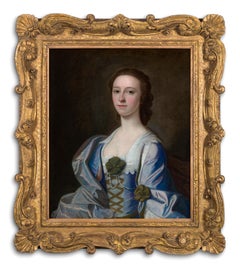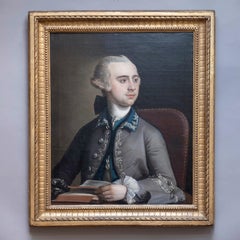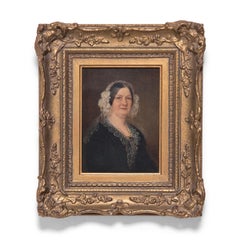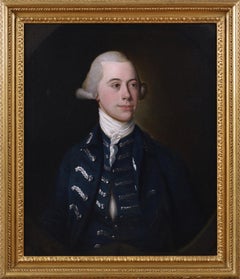Presented by Titan Fine Art, this painting formed part of a historic collection of an English aristocratic family, Lord and Lady Sandys at their magnificent baroque and Regency Grade-I listed family home, Ombersley Court. The house was among the most fascinating survivals of its kind in this country. The atmospheric interiors were distinguished above all for the works of art associated with two key moments in national history. The collection was acquired or commissioned over five centuries and remained at Ombersley Court until its recent sale, the first in 294 years. This portrait hung in the Grand Hall.
This exquisite grand manner work is an evocative example of the type of portrait in vogue during a large part of the seventeenth and eighteenth centuries. The artist has depicted an elegant lady, three quarter length and seated on porch with a luxurious crimson swag curtain by her side. The clothing – known as “undress” at the time, consists of red silk fastened at the front and sleeves by large gold and diamond jewels over a simple white chemise. In her lap she holds a blue wrap and in her other hand, at her chest, she clutches the end of a sheer gauzy scarf that has been draped around her body with the other end a type of headdress – this type of sheer scarf was often employed by Wissing in his portraits. The classical architecture signifies cultivation and sophistication and the luxurious swag curtain is a signifier of wealth. The portrait can be dated to circa 1680 based on the sitter’s attire, the “hurluberlu” hairstyle, and other portraits by Wissing using the same formula.
This oil on canvas portrait has been well cared for over its life, which spans almost 350 years. Having recently been treated to remove an obscuring discoloured varnish, the finer details and proper colour can now be fully appreciated.
Once owned by Evesham Abbey, the manor of Ombersley was acquired by the Sandys family in the early 1600s, when Sir Samuel Sandys, the eldest son of Edwin Sandys, Bishop of Worcester and later Archbishop of York, took a lease on the manor, before receiving an outright grant in 1614. The present house, Ombersley Court, dates from the time of Samuel, 1st Lord Sandys, between 1723 and 1730. The house itself is a fine example of an English Georgian country house set in rolling countryside and surrounded by Wellingtonias, planted to commemorate the Battle of Waterloo by Arthur Hill, 2nd Baron Sandys, who played a distinguished part in the battle and was one of the Duke of Wellington’s aides de camp. The Duke also stayed in the house and in the Great Hall, was the Waterloo banner which was brought to the house by Sir Arthur Hill, aide-de-camp to the Duke of Wellington, who succeeded his mother, the Marchioness of Downshire as 2nd Lord Sandys. Further Waterloo memorabilia are kettle drums from battle. The family had a strong tradition of military and political service, dating back to the 17th century, and this was also reflected in the fine collection of portraits and paintings in the house. In short, Ombersley represented a vital aspect of British history. The house and more especially the collection were of the greatest historical importance. Houses that have remained in the possession of the same family for as many as three centuries have become increasingly rare.
Through this portrait, collectors have a chance to acquire a piece of British history and an evocative vestige of a glittering way of life, which is now gone.
Much of the attractiveness of this portrait resides in its graceful manner and the utter beauty of the youthful sitter. Presented in a beautiful carved and gilded period frame, which is a work of art in itself.
Willem Wissing was a Dutch artist who enjoyed a solid artistic training at The Hague under Arnold van Ravesteyn (c.1650-1690) and Willem Dougijns (1630-1697). He came to London in 1676 and most probably joined the studio or Sir Peter Lely as an assistant that same year. After Lely’s death in 1680 he effectively took over his business and he scaled the heights of patronage with extraordinary ease, creating an independent practise in 1687, and painted for very important aristocratic patrons. King Charles II was so impressed by a portrait Wissing painted of his son, the Duke of Monmouth, in 1683 that he commissioned his own portrait and that of his
Queen Catherine...





